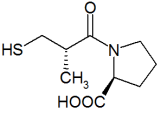Pitt B, Poole-Wilson PA, Segal R, et al. Effect of losartan compared with captopril on mortality in patients with symptomatic heart failure: randomized trial-the Losartan Heart Failure Survival Study ELITE II. Lancet 2000; 355:1582-87.
* BACKGROUND Because of their beneficial effects on mortality risk and functional status, angiotensin-converting-enzyme (ACE) inhibitors should be prescribed for all patients with heart failure and systolic left ventricular dysfunction unless specific contraindications exist. However, some physicians do not prescribe them because of fear of adverse effects. Angiotensin II type 1 receptor blockers ([AT.sub.1]RBs) may be better tolerated than ACE inhibitors. A secondary analysis of 49 deaths in the original Evaluation of Losartan in the Elderly (ELITE) study, in which the primary end point was the effect of treatment on renal function, showed an unexpected survival benefit for the [AT.sub.1]RB losartan over captopril, an ACE inhibitor. ELITE II was a larger trial designed to confirm whether losartan is superior to captopril in reducing all-cause mortality in elderly heart failure patients.
* POPULATION STUDIED The study included 3152 patients aged 60 years or older with New York Heart Association class II to IV heart failure and an ejection fraction of 40% or less. Most of the patients recruited from the 289 outpatient centers in 46 countries were white men aged older than 65 years who had never received an ACE inhibitor or an [AT.sub.1]RB. Exclusion criteria included previous intolerance or contraindication to either the study drug, systolic blood pressure greater than 90 mm Hg, uncontrolled hypertension, obstructive valvular heart disease, recent cardiac procedure or event, anticipated cardiac surgery, or recent cerebrovascular event.
* STUDY DESIGN AND VALIDITY This study was a prospective randomized double-blind trial funded by the manufacturer of losartan. Designed as an event-driven superiority trial, the study had 90% power to detect a relative 25% difference in all-cause mortality between treatments. At each study center, randomization was stratified on the basis of use of [Beta]-blockers. After a single-blind run-in period of 1 to 28 days, 1578 patients were allocated to losartan (12.5 mg titrated to a maximum of 50 mg once daily) and 1574 to captopril (12.5 mg titrated to a maximum of 50 mg 3 times daily). Clinical assessments were done weekly during dose titration and then every 4 months. Periodic laboratory assessments were also performed.
The appropriate study design and intention-to-treat analysis were used for this efficacy trial. Neither the patients, those assessing clinical outcomes, nor the drug safety monitoring committee were aware of treatment status. Concealed allocation to treatment group at each study site was assured through central block randomization. The results are only applicable to elderly patients.
* OUTCOMES MEASURED The primary outcome was all-cause mortality, and the secondary end point was the composite of sudden cardiac death or resuscitated cardiac arrest.
* RESULTS Treatment groups were well matched demographically and for confounding variables that might affect response to treatment. Only 1 patient from each group was lost to follow-up during a median follow-up period of 18 months. A total of 280 deaths (17.5%) occurred in the losartan group compared with 250 (15.9%) in the captopril group, with an annual mortality rate of 11.7% and 10.4%, respectively (hazard ratio=l.13; 95.7% confidence interval, 0.95-1.35; /2=-.16). Neither of these differences was statistically significant, but power may have been an issue. Similarly, there was no significant difference in the composite of sudden death or resuscitated arrests (9.0% vs 7.3%). Fewer patients in the losartan group (excluding those who died) discontinued treatment because of side effects (9.7% vs 14.7%, P [is less than] .001).
RECOMMENDATIONS FOR CLINICAL PRACTICE
Clinicians should continue to prescribe ACE inhibitors as initial treatment for elderly patients with symptomatic heart failure. Losartan was clearly not superior (or even Equivalent) to captopril in reducing all-cause mortality and should not be used as first-line therapy for these patients.
Thomas H. Trojian, MD Eric A. Jackson, PharmD University of Connecticut School of Medicine Saint Francis Hospital and Medical Center Hartford, Connecticut E-mail: ejackson2@stfranciscare.org
COPYRIGHT 2000 Appleton & Lange
COPYRIGHT 2001 Gale Group



